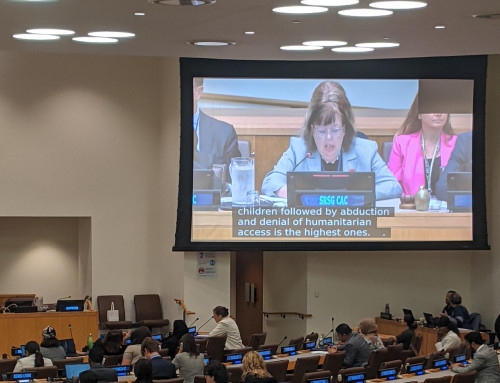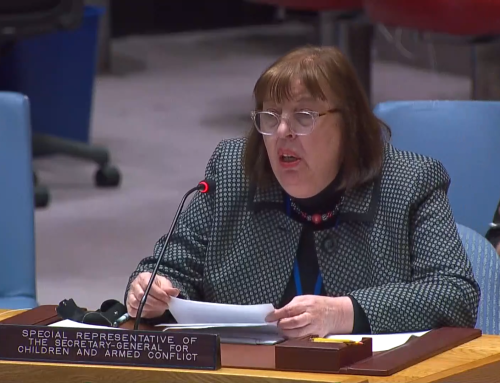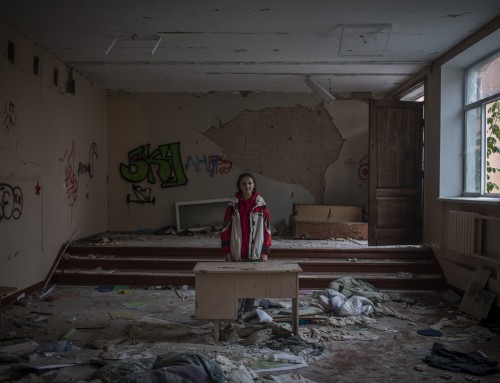Strengthening the Protection of Education during Armed Conflict
Remarks by Leila Zerrougui, delivered on Monday December 14, 2015
at the Palais des Nations, Geneva
Please check against delivery
Excellencies, dear colleagues,
Let me first thank the Permanent Missions of Norway and Argentina for holding this event, as well as all the sponsors who contributed to the organization. I am very pleased to be here in person to reiterate to the Geneva community my support for the Safe Schools initiative, as I have done on many other occasions to your colleagues in New York and elsewhere. I would like to take this opportunity to share why I consider that strengthening the protection of education is an absolute and immediate priority.
Every child, everywhere, has the right to education. Sustainable Development Goal Four reminds us that we need to “ensure inclusive and equitable quality education and promote lifelong learning opportunities for all”. However, in conflicts around the world the right to education is largely compromised for millions of children who are already in a very vulnerable situation. As a result of attacks on schools, teachers and students, but also military use of schools, many countries risk losing the future of entire generations of children.
Let me start by highlighting the magnitude and severe impact of attacks on education in situations of armed conflict. Thousands of schools are being destroyed and damaged in direct attacks and as collateral damage. For example, in Syria, an estimated 5,000 schools have been fully destroyed and almost 1,000 were partially destroyed during the conflict. Regarding those displaced outside the country, seventy per cent of Syrian refugee children do not have access to education. In Yemen, the impact on education since the escalation of conflict in March of this year is alarming. Schools have been hit during ground offensives, but mostly in the course of heavy aerial bombardment and over 500 schools have been damaged or destroyed in just over six months. UNICEF reports that 34% of children in Yemen have not been to school since the air strikes first began.
Students are also being killed and maimed. In Afghanistan and Nigeria, but also in Pakistan, girls are targeted for pursuing their right to education. However, it is not just girls who suffer violence. On Wednesday, we will witness the sad one-year anniversary of the attack on the Peshawar Army Public School in Pakistan, in which 265 boys and several teachers were killed and injured. Children have also been abducted from schools and forcedly recruited in Central African Republic, Nigeria and South Sudan, to name just a few. These are just some examples of the many violations that are a woeful feature of conflict today.
Excellencies, dear colleagues,
Allow me to also highlight the repercussions of the military use of schools. Using schools for military purposes erodes their sanctity as safe spaces and compromises their civilian status, which exposes them to the risk of targeted attacks by other parties and puts children in harms way. In addition, when used as barracks, or training grounds, or even as weapons stores, the facilities are often looted, damaged, and contaminated with unexploded ordnances. Using schools, even for a few days can have lasting repercussions. It takes a long time and a lot of resources to repair the physical infrastructure, refurbish the building, and reinstall skilled teachers required to restore quality education. These are investments that conflict and post-conflict societies can seldom afford.
The militarization or the proximity of armed actors to school environments also risks facilitating recruitment of children or aiding attempts to use them for intelligence gathering. In some instances, armed actors have also used their proximity to education institutions for propaganda and indoctrination purposes, including through changing education curricula. The militarization of schools also leaves children vulnerable to other grave violations. In almost every situation where schools are militarized, children say that they are afraid to return to school as they fear being harmed, abducted, recruited, or raped.
It is apparent that when children lose their protective environment, when their schools are closed, occupied or destroyed, their families have no other option but to flee and seek a safer environment. It is every parent’s imperative to provide their children with opportunities for a better future. We must collectively make every effort to ensure that schools in conflict zones remain open and function without interruption. We must also ensure that teachers and children are safe in order to maintain a sense of normalcy, build resilience, and promote reconciliation. This can only help our goals of avoiding mass displacement of populations.
The Security Council, in resolution 2143 (2014), reaffirmed its goal of preserving the right to education for all children and recognised the negative impact of attacks on education. That resolution also added a crucial new request to Member States: it asked that they engage in formulating concrete measures to deter the military use of schools. With the publication a year ago of the “Guidelines for Protecting Schools and Universities from Military Use during Armed Conflict” and with the adoption of the “Safe Schools Declaration” in Oslo in May of this year, Member States have been given a voluntary framework for achieving this aim. In this regard, I wish to welcome the efforts of all of you, Governments and NGOs alike, for your work to strengthen the protection of education through these advocacy tools. I call on the Member States who have not yet done so to endorse the Safe Schools Declaration. As the Secretary-General’s Special Representative for Children and Armed Conflict, I joined the wider call for UN partners, international organizations and civil society to collaborate to strengthen the protection of education during armed conflict by signing the Open Pledge that was made at last week’s 32nd International Conference of the Red Cross and Red Crescent.
As part of the efforts developed by my Office to strengthen the protection of education, I would like to mention the guidance note on the monitoring and reporting of attacks on schools and hospitals published in May 2014 and which includes a Draft Operational Strategy for the prevention of military use of schools. This practical tool is being used as a basis for advocacy when military elements are seen using school premises, be they Government forces, non-State armed groups, or peacekeepers. Let me also seize this opportunity to highlight the dedication of our teams on the ground (the Country Task Forces for monitoring and reporting) for advocating relentlessly with national authorities and parties to conflict for the protection of schools, including by encouraging the endorsement of the Safe Schools Declaration.
Excellencies, dear colleagues,
One may ask: what should we do to ensure schools are kept safe during times of war? Ensuring accountability for grave violations against children, including for attacks on schools, is the best way to prevent their recurrence. Accountability comes in many forms, but Governments bear the primary responsibility for protecting civilians, pursuing accountability and promoting changes in behaviours within military forces. States must issue command orders to their security forces to protect schools and safe access to education, and take precautionary measures to avoid harm to civilians.
To conclude, we know too well the long-term and devastating repercussions of attacks against and military use of schools on children’s right to education. When a community is recovering from conflict, it can take decades to be able to restore quality education for all, even after a short period of hostilities. We cannot tolerate any longer that in too many countries, education has become “more a fight than a right”, as rightly said by my Human Rights Watch colleague, Bede Sheppard. It is therefore urgent to make every effort to protect schools to be able to provide them a safe space and speed up recovery.





